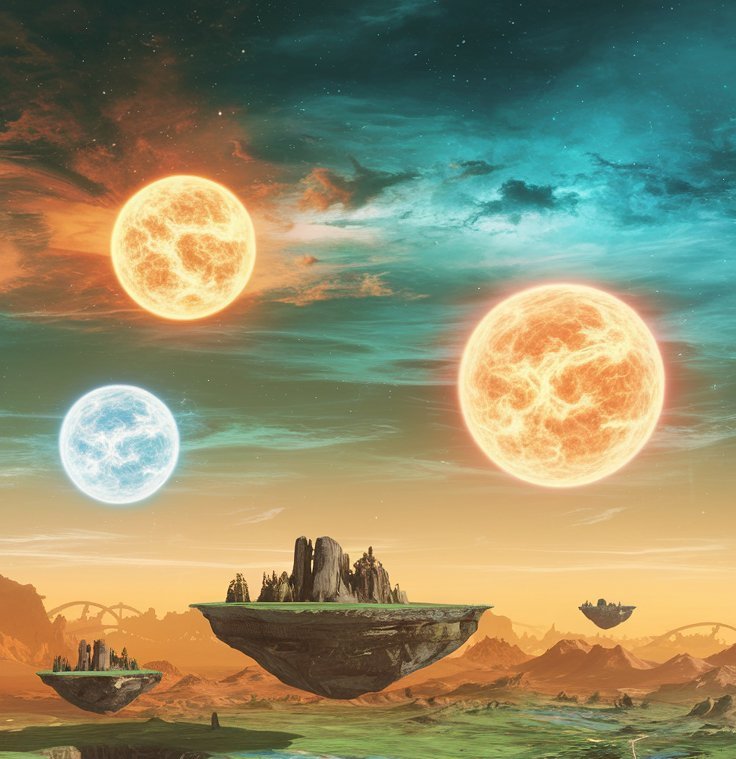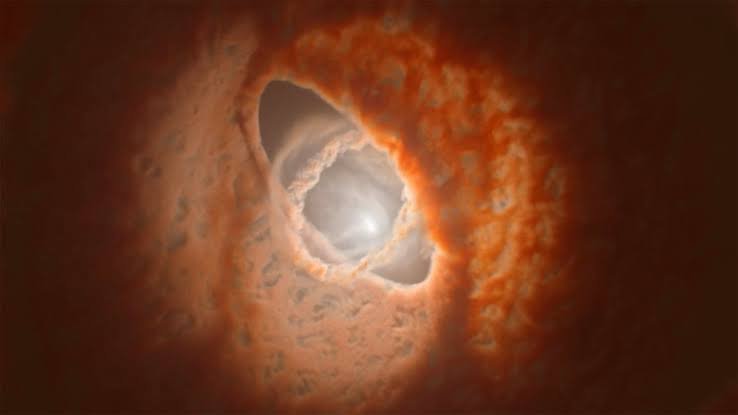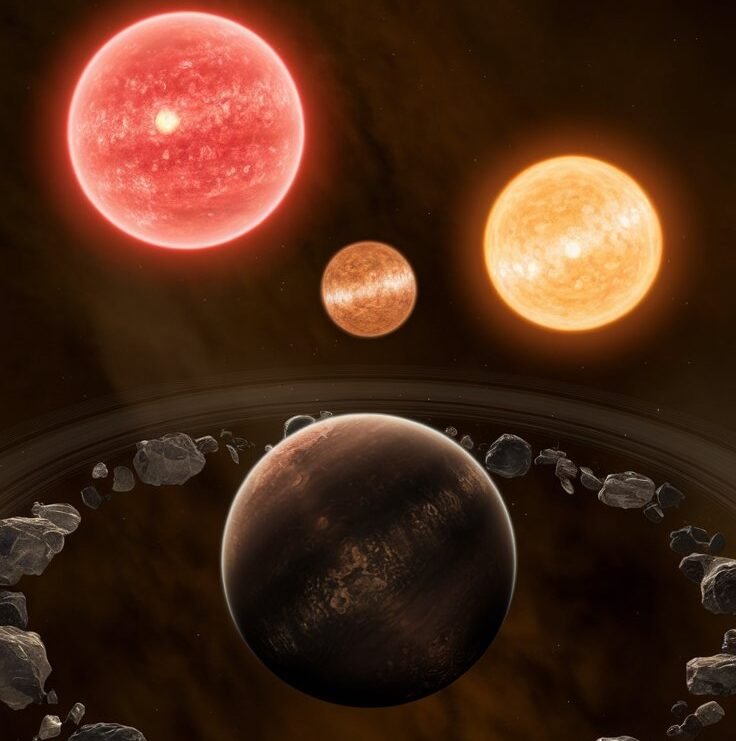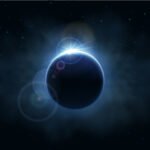INTRODUCTION
In the vastness of space, we often envision planets orbiting a single star. However, an even more thrilling concept exists—planets that orbit multiple stars. This isn’t the stuff of science fiction or fantasy. Since the early 21st century, we’ve had real-life proof of such planets, known as circumbinary or circumtriple planets, depending on the number of stars.
Imagine living on a planet where you witness two or even three sunrises and sunsets. Picture seeing multiple suns in the sky each day. While these awe-inspiring views are remarkable, they aren’t the only defining features of life on planets within multi-star systems. The challenges of living in these environments also come into play and must be addressed.
Let’s dive deeper and gain a broader understanding of the unique aspects of these extraordinary planets.

1.CIRCUMBINARY SYSTEM
A circumbinary planet exists within a system of two stellar bodies, typically stars, that orbit around a shared center of mass, or barycenter. These systems are fascinating, but they come with the risk of planets being flung out due to minor alterations in their stability. The delicate gravitational dance between stars and planets in such systems makes them intriguing but precarious environments.
The first confirmed discovery of a planet in such a system occurred in 1998, with PSR B1620-26. This system includes a pulsar (PSR B1620-26 A) and a white dwarf (WD B1620-26), located approximately 23 astronomical units (AU) apart—slightly farther than the distance between Uranus and the Sun. Orbiting this system is a planet 2.5 times the size of Jupiter, nicknamed “Methuselah” or “The Genesis Planet.”
However, the discovery of PSR B1620-26 was overshadowed on September 15, 2011, by Laurence Doyle’s discovery of another circumbinary planet, Kepler-16b, during the Kepler transit mission. Kepler-16b is a fascinating half-gas, half-rock-and-ice planet often compared to the fictional planet “Tatooine” from Star Wars. Due to this similarity, it earned the nickname “the real-life Tatooine.” Located 245 light-years from Earth in the constellation Cygnus, Kepler-16b orbits two stars: Kepler-16A, a K-type star similar to our Sun, and Kepler-16B, an M-type red dwarf.
Following the discovery of Kepler-16, another circumbinary system—Kepler-47—was identified in 2012. Situated 3,420 light-years away, also in the constellation Cygnus, this system contains two stars: Kepler-47A, a G-type main sequence star, and Kepler-47B, a red dwarf. What makes Kepler-47 particularly notable is that it was the first circumbinary system discovered to have more than one planet, boasting four planets in total.
The exploration of these extraordinary systems continues to deepen our understanding of the complex and dynamic nature of the universe.
ORBITAL DYNAMICS OF THE CIRCUMBINARY PLANETS:
The study and prediction of the movement of circumbinary systems, known as orbital dynamics, are illuminated by two key concepts: the Two-Body Problem and the Three-Body Problem. The Two-Body Problem focuses on predicting the motion of the two stars within the circumbinary system, where both stars orbit around a shared center of mass, called the barycenter. The Three-Body Problem extends this concept by analyzing the more complex movement of planets around the two stars.
The barycenter is the common center of mass between two or more orbiting bodies in space. It exists due to the gravitational pull between the bodies, and its position is determined by their respective masses. The more massive the object, the closer the barycenter is to it. In some cases, such as with Earth and the Moon or Earth and the Sun, the barycenter may lie within the larger body itself, which affects how we perceive the orbital motion from our vantage point.
In circumbinary systems, unlike simpler systems, the barycenter is located in a region of space where the orbits of both stars interact. This creates a dynamic environment, as both stars orbit around this shared point, leading to a complex gravitational dance. The Three-Body Problem is used to describe the interaction between the two stars and any orbiting planets. However, this relationship is notoriously difficult to predict, as the Three-Body Problem lacks an exact analytical solution, making the planet’s movements somewhat chaotic and unpredictable.
Despite these challenges, astronomers have identified several hurdles that a planet must overcome to form and remain stable within such a system. To ensure the planet avoids being flung out or disrupted by the gravitational forces of the two stars, certain conditions must be met. These challenges include:

- DISTANCE: The planet’s orbit must be at least 2-4 times the separation of the stars to avoid destabilizing gravitational forces.
- RESONANCE: The planet must be in a gravitational resonance with the binary star system to maintain a stable orbit. For instance, a planet might have a 2:1 resonance, meaning it completes one orbit around the barycenter for every two orbits of the binary stars. This resonance helps synchronize the planet’s orbit with the stars’ movements, contributing to orbital stability.
- ECCENTRICITY OF ORBITS: The planet’s orbit should have low eccentricity, meaning it should be more circular rather than elongated. A low eccentricity ensures a more uniform gravitational distribution, which contributes to a more stable orbit.
- INCLINATION OF ORBITS: The planet’s orbit should be coplanar with the binary stars’ orbit. This means that the planet’s orbit should lie in the same plane as the orbits of the two stars. Coplanar orbits generally result in greater stability, reducing the risk of gravitational disturbances.
CHALLENGES FACED BY CIRCUMBINARY PLANETS
Despite the cool views and unique astronomical conditions, planets in circumbinary systems face numerous challenges that can lead to chaotic periods. These challenges include:In a circumbinary system, a planet must navigate several dynamic and challenging effects:
- GRAVITATIONAL TUG-OF-WAR: The dual gravitational forces from the two stars can create conflicting pulls on the planet. This tug-of-war effect can disrupt the planet’s orbit or lead to significant fluctuations in its trajectory.
- ORBITAL INSTABILITY: The varying gravitational influences from the binary stars can cause the planet’s orbit to become highly unstable. This instability leads to unpredictable and erratic orbital paths.
- COLLISION HAZARDS: The planet may face risks of collisions with residual gas and dust from the protoplanetary disk. These collisions can hinder the planet’s formation or cause significant damage.
- VARIABLE STELLAR RADIATION: The planet experiences substantial fluctuations in heat and light due to the presence of two stars. These variations can lead to extreme environmental changes, impacting the planet’s stability and formation.
If we delve further into multi-star systems, we find that circumbinary systems are relatively simple compared to the complexities of circumtriple systems.
CIRCUMTRIPLE SYSTEM
Circumtriple systems, which contain three stellar bodies bound together by a complex orbit, present even greater challenges than circumbinary systems. The movement of the stars in a circumtriple system is highly unpredictable, leading to a higher likelihood of chaotic periods or even the total destruction of a planet.The first discovery of a circumtriple system occurred in 1991 with the identification of GW Orionis. This star system, located in the constellation Orion and 1,312 light-years from our Sun, features three massive disks of dust and gas, as well as three stars: Ori A, Ori B, and Ori C. There is a hypothesis that a planet may be forming in a gap between these disks.Another intriguing discovery in the realm of circumtriple systems is CWISE J235827.96-521813.4, abbreviated as CW2335+0142, or Gliese 900 b. This planet, approximately 10.5 times the size of Jupiter, has an exceptionally long orbital period of 1.27 to 1.4 million years, making it the record holder for the longest orbital period ever discovered. Austin Rothermich, who made the discovery in 2024, has significantly expanded our understanding of the Gliese 900 system, revealing it to be a circumtriple system rather than just a triple star system. Located in the constellation Pisces, just 68 light-years from the Sun and within the Milky Way, this discovery has provided new insights into the dynamics of multi-star systems.https://en.wikipedia.org/wiki/Gliese_900
The fascination with circumtriple systems has been further popularized by the science fiction novel The Three-Body Problem by Cixin Liu. This book explores the unpredictable nature of orbital dynamics within such systems, capturing the complexities and challenges described in real-life circumtriple systems. Liu’s portrayal of these astronomical phenomena has not only sparked interest but also deepened our understanding of the chaotic behaviors that can occur in multi-star systems.

ORBITAL DYNAMICS OF CIRCUMTRIPLE SYSTEM
In circumtriple systems, the Three-Body Problem governs the movement of the stars, adding another layer of complexity. The interactions between the three stars make their movements highly unpredictable, increasing the likelihood of chaotic periods. Despite these challenges, circumtriple systems also exhibit rare dynamics that can enhance the chances of planetary formation and survival. These dynamics include:
- ORBITAL STABILITY: Planets in circumtriple systems must contend with the gravitational forces of three stars, resulting in a highly dynamic and potentially unstable environment. This constant gravitational interplay can significantly affect the planet’s orbit, making stability a key challenge.
- ORBITAL SHAPE: The orbits of planets in circumtriple systems can be highly elliptical. This results from the varying gravitational pulls exerted by the three stars, which can lead to significant deviations from circular orbits.
- PRECESSION: The planet’s orbit can experience precession, where the orientation of the orbit shifts over time. This change is caused by the gravitational influences of the three stars, affecting the long-term stability and predictability of the planet’s path.
- LIBRATION AND CIRCULATION: Depending on the initial conditions, the planet’s orbit can exhibit two behaviors: it may librate, meaning it oscillates around a stable point, or it may circulate, continuously changing direction. These behaviors are influenced by the complex gravitational interactions within the circumtriple system.
These dynamics make circumtriple planets both rare and challenging to form and detect, resulting in their scarcity in the universe. The intricate gravitational interactions and orbital complexities contribute to their rarity. Additionally, the ongoing challenges these planets face make their long-term existence a remarkable feat.
CHALLENGES FACED BY CIRCUMTRIPLE PLANETS
Orbiting stars in a system with multiple stellar bodies introduces numerous and complex challenges for any planet in such a configuration. Achieving stability and enduring over long periods in these systems is a remarkable feat. Some of the challenges these planets face include:
- GRAVITATIONAL INSTABILITY: The gravitational forces from three stars can create a highly unstable environment, making it challenging for planets to maintain stable orbits. The complex interactions between the stars’ gravitational fields can lead to significant perturbations in a planet’s trajectory.
- ORBITAL PERTURBATIONS: The varying gravitational pulls from the three stars can cause significant perturbations in the planet’s orbit. This can result in highly elliptical or even chaotic trajectories, further complicating the planet’s stability.
- FORMATION CHALLENGES: The process of planet formation in a circumtriple system is inherently complex. Gravitational interactions can disrupt the protoplanetary disk, making it difficult for planets to form and grow. These disruptions can hinder the accumulation of material needed for planet formation.
- RADIATION EXPOSURE: The planet’s exposure to radiation from three stars can significantly impact its atmosphere and potential habitability. The combined radiation from multiple stars may lead to increased atmospheric erosion or other challenges that affect the planet’s ability to support life.
- DISK WARPING: The protoplanetary disk around the stars can become warped and tilted due to the gravitational influences of the three stars. This warping complicates planet formation and stability, as the irregularities in the disk can lead to uneven distribution of material and affect the planet’s orbital dynamics
GENERAL CONCLUSION
The challenges faced by planets with multiple suns—ranging from complex gravitational dynamics to unpredictable orbits—highlight the extraordinary environments in which these worlds exist. Despite these difficulties, recent discoveries confirm the existence of circumbinary and circumtriple planets, broadening our understanding of planetary formation and survival.Intriguingly, new research, known as the Nemesis Hypothesis, suggests that most stars, including our own Sun, are born with a twin star. According to this hypothesis, our solar twin may have been lost eons ago after completing approximately 12 orbits around the Milky Way. Although it has long vanished, evidence of its existence might still be present in the Oort Cloud, a distant reservoir of icy bodies at the edge of our solar system. These findings not only reshape our view of multiple star systems but also hint at a hidden chapter in our own solar history, suggesting that our Sun once shared its journey with a long-lost sibling. This topic, however, is a fascinating discussion for another time.








